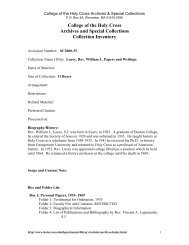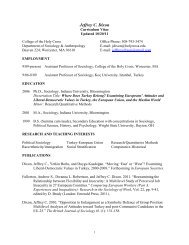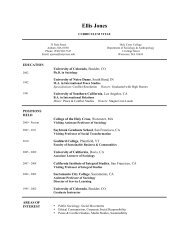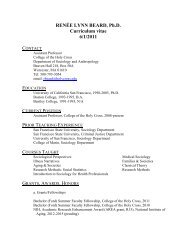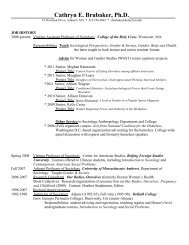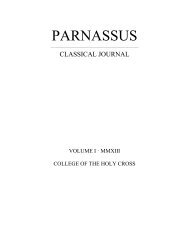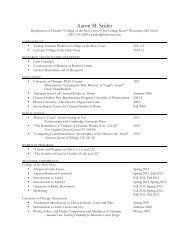Control of frequency in cricket song - The Journal of Experimental ...
Control of frequency in cricket song - The Journal of Experimental ...
Control of frequency in cricket song - The Journal of Experimental ...
You also want an ePaper? Increase the reach of your titles
YUMPU automatically turns print PDFs into web optimized ePapers that Google loves.
several hundred; quartz oscillators have far greater Q values<br />
and are far more accurate (Landes, 1983; Fletcher, 1992). In<br />
contrast, <strong>cricket</strong> harps must both control the fC and act as an<br />
effective radiator. To be a good radiator, the harp must be<br />
damped by high radiation resistance (Bennet-Clark, 1975,<br />
1989). This reduces Q s<strong>in</strong>ce it is proportional to the ratio <strong>of</strong><br />
system mass to the radiation (damp<strong>in</strong>g) resistance (equation 7).<br />
<strong>The</strong> low Q (Q=18 <strong>in</strong> A. arboreus) makes it possible to drive<br />
the harp over a wider range <strong>of</strong> frequencies than if it were less<br />
damped.<br />
A low Q permits <strong>frequency</strong> variation, but what mechanism<br />
is responsible for produc<strong>in</strong>g such variation? Not only does fC<br />
variation occur between pulses but also, <strong>in</strong> most species, there<br />
is pronounced with<strong>in</strong>-pulse <strong>frequency</strong> modulation. We found<br />
a 9 % <strong>in</strong>tra-pulse decrease <strong>in</strong> fC <strong>in</strong> A. arboreus (Table 1) similar<br />
to other values for gryllids (Alexander, 1957; Leroy, 1966;<br />
Koch et al., 1988). Recently, Simmons and Ritchie (1996)<br />
showed that the degree <strong>of</strong> <strong>in</strong>tra-pulse <strong>frequency</strong> modulation <strong>in</strong><br />
G. campestris depends on the relative dimensions and therefore<br />
the masses <strong>of</strong> the left and right harps. In experiments <strong>in</strong> which<br />
they ablated one or the other harp, their results suggest that the<br />
resonance <strong>of</strong> the left (usually smaller) harp is largely<br />
responsible for sett<strong>in</strong>g the fC dur<strong>in</strong>g the <strong>in</strong>itial third <strong>of</strong> the<br />
pulse. <strong>The</strong> right harp, which is usually larger, with a lower f0,<br />
then becomes dom<strong>in</strong>ant for the rema<strong>in</strong>der <strong>of</strong> the pulse. <strong>The</strong>se<br />
surpris<strong>in</strong>g results have recently been replicated <strong>in</strong> A. arboreus<br />
(K. N. Prestwich, unpublished data).<br />
Bennet-Clark (1999) believes that these data show that the<br />
resonat<strong>in</strong>g system’s mass <strong>in</strong>creases dur<strong>in</strong>g the tegm<strong>in</strong>al<br />
closure. He argues that the fC is typically lower than the<br />
tegm<strong>in</strong>al free resonance (see, for example, our data for G.<br />
rubens) and concludes that, when the two harps are coupled<br />
together via the stridulatory apparatus, mass is added to the<br />
system. He cautions that little is known <strong>of</strong> the exact<br />
mechanism, but speculates that the cause is a shift <strong>in</strong> effective<br />
mass caused by changes <strong>in</strong> the po<strong>in</strong>t from which the right harp<br />
is excited dur<strong>in</strong>g a w<strong>in</strong>g stroke. Although the left (lower) harp<br />
is driven throughout the tegm<strong>in</strong>al closure from its medial apex<br />
via the plectrum, the driv<strong>in</strong>g po<strong>in</strong>t for the right (more massive)<br />
harp moves laterally from its medial apex as the contact po<strong>in</strong>t<br />
with the plectrum skips along the file. If the vibrat<strong>in</strong>g mass<br />
changes as a function <strong>of</strong> the relative sizes <strong>of</strong> the left and right<br />
harps and the position <strong>of</strong> the plectrum on the file, then it is easy<br />
to imag<strong>in</strong>e that pulse-to-pulse differences <strong>in</strong> fC could be due to<br />
differences <strong>in</strong> the po<strong>in</strong>t where the plectrum first contacts the<br />
file.<br />
So, it is clear that <strong>cricket</strong>s are not as accurate as f<strong>in</strong>e Swiss<br />
watches. However, both watches and <strong>cricket</strong>s are controlled by<br />
escapement mechanisms. <strong>The</strong> work<strong>in</strong>gs <strong>of</strong> a watch are<br />
optimized to keep time accurately for human uses. Crickets use<br />
an analogous escapement/regulator mechanism, but optimize<br />
its operation to make brief loud signals at a <strong>frequency</strong> as near<br />
as possible to the peak auditory sensitivity <strong>of</strong> conspecific<br />
females. Call<strong>in</strong>g males seek to attract mates and make time,<br />
not keep time. We might add that watches are also used to<br />
attract mates, but the mechanism <strong>in</strong> this case is different.<br />
<strong>Control</strong> <strong>of</strong> <strong>frequency</strong> <strong>in</strong> <strong>cricket</strong> <strong>song</strong><br />
595<br />
List <strong>of</strong> symbols<br />
BW−3dB,SPL bandwidth at 3 dB SPL re 20 μPa below<br />
the peak<br />
c speed <strong>of</strong> sound<br />
C compliance<br />
f0,air<br />
resonant <strong>frequency</strong> <strong>in</strong> air<br />
fC<br />
carrier <strong>frequency</strong><br />
f0<br />
resonant <strong>frequency</strong><br />
fPFI<br />
plectrum-to-file impact rate<br />
f0,heliox-air resonant <strong>frequency</strong> <strong>in</strong> heliox-air<br />
fWS<br />
w<strong>in</strong>g stroke or sound pulse rate<br />
L <strong>in</strong>ertance<br />
Lair<br />
<strong>in</strong>ertance <strong>of</strong> air mov<strong>in</strong>g en masse together<br />
with the vibrat<strong>in</strong>g harp<br />
Lgas<br />
<strong>in</strong>ertance <strong>of</strong> any gas mov<strong>in</strong>g en masse<br />
together with the vibrat<strong>in</strong>g harp<br />
Lharp<br />
<strong>in</strong>ertance <strong>of</strong> the harp<br />
Lheliox-air <strong>in</strong>ertance <strong>of</strong> heliox-air mov<strong>in</strong>g en masse<br />
together with the vibrat<strong>in</strong>g harp<br />
l′ effective length<br />
loge(decrement) the natural logarithm <strong>of</strong> the rate <strong>of</strong><br />
decrease <strong>of</strong> the amplitude <strong>of</strong> an<br />
undriven oscillation<br />
M mass<br />
P0<br />
pressure <strong>in</strong> the absence <strong>of</strong> sound<br />
Q quality factor<br />
R damp<strong>in</strong>g (specific acoustic) resistance<br />
S cross-sectional area<br />
SPL sound pressure level, re 20 μPa<br />
V volume<br />
γ dimensionless ratio <strong>of</strong> specific heats<br />
λ wavelength<br />
ρ density<br />
We wish to thank Dr Thomas J. Walker and the<br />
Department <strong>of</strong> Entomology and Nematology at the<br />
University <strong>of</strong> Florida for generously provid<strong>in</strong>g K.N.P. with<br />
research space and for numerous useful and stimulat<strong>in</strong>g<br />
discussions. Pr<strong>of</strong>essor Henry Bennet-Clark <strong>of</strong> Oxford<br />
University provided us with a number <strong>of</strong> excellent ideas<br />
relat<strong>in</strong>g to certa<strong>in</strong> <strong>of</strong> our experiments and also posed<br />
stimulat<strong>in</strong>g questions and <strong>in</strong>valuable <strong>in</strong>sights dur<strong>in</strong>g the<br />
preparation <strong>of</strong> this manuscript, and we are very grateful to<br />
him. Similar thanks goes to an anonymous reviewer <strong>of</strong> this<br />
manuscript, especially for her/his suggestions deal<strong>in</strong>g with<br />
the role <strong>of</strong> radiation mass and for stylistic comments.<br />
Special gratitude goes to Dr Cather<strong>in</strong>e Langtimm <strong>of</strong> the<br />
Biological Resources Division <strong>of</strong> the US Geological Survey<br />
and Holy Cross College for her help with certa<strong>in</strong><br />
experiments and analysis and for her suggestions relat<strong>in</strong>g to<br />
the manuscript. We <strong>of</strong>fer additional thanks for helpful<br />
discussions, advice and materials to our Holy Cross<br />
colleagues Dr George H<strong>of</strong>fmann <strong>of</strong> the Biology Department<br />
and Drs Jan<strong>in</strong>e Shertzer, De-P<strong>in</strong>g Yang and Robert Garvey<br />
<strong>of</strong> the Physics Department. We also wish to thank Dr Alice<br />
Deckert <strong>of</strong> the Chemistry Department at Allegheny College



